
One of THE BEST ways to keep in touch with your donors is through nonprofit newsletters.
Donors want to stay in the loop of what’s going on in your organization. Yet, it’s hard for them to stay excited about your work if they don’t know what’s happening.
Sending regular newsletters is a great way to not only give them the latest updates, but make them feel great about supporting your nonprofit’s work.
There are pros and cons of sending the newsletter in print and by email. Let’s focus on email newsletters or e-newsletters since that’s probably the fastest and most affordable way to send your newsletter (and that’s how most of our clients send their newsletters).
With email builder tools like Mail Chimp and ConstantContact, you can customize an email template that you can reuse over and over. You can also easily schedule emails to go out any day and time that works for you and your audience, which is super convenient.
There are two parts to a successful newsletter: Content (what you share) and set up (how it’s put together).
Let’s take a look at both along with some best practices that can save you a lot of time and prevent mistakes.
What to include in your e-newsletter
Content is key if you want to create the ultimate donor newsletter.
Like any magazine or newspaper, if the articles aren’t interesting, people stop reading. And that defeats the whole purpose.
 Spending time thoughtfully choosing the right stories and the right angle for each story will pay off big in getting people to READ your newsletter. If they don’t read it, they won’t take the action you want them to take, so this part is critically important!
Spending time thoughtfully choosing the right stories and the right angle for each story will pay off big in getting people to READ your newsletter. If they don’t read it, they won’t take the action you want them to take, so this part is critically important!
There are so many things that can happen in your nonprofit in a month or even in a week and it’s tempting to include it all. The key is to include only those things that your donor is interested in.
That means you have to strategically think through what you want to write about and write it in a donor-centric way.
To get you started, here are the top pieces you should share in your e-newsletter:
- Success stories. Your donors and followers love to see success happening in your nonprofit, and happy-ending stories demonstrate that success beautifully. Kick off your e-newsletter with your best story chock-full of heart-tugging details.
- Update on a program or project. If you’ve recently asked for support for a program, share an update on how the program is doing and the outcomes from the program so donors can see how their donation is making a difference.
- Save the Date. List out any upcoming events or activities so people can put them on their calendar.
- How You Can Help. Let folks know what they can do to get involved whether it’s through volunteering, organizing a supply drive, or inviting you to speak at their Rotary club. Steer away from asking for money here – your newsletter is meant to be a communication tool, not a fundraising tool.
If you include those sections in your e-newsletter template, then each month you just fill them in. That makes creating content for nonprofit newsletters easier than staring at a blank screen wondering what you’re going to write.
Once you get the content figured out, it’s time to set up your newsletter.
15 Best Practices in Setting Up Nonprofit Newsletters
Setting up nonprofit newsletters is about the technical side of putting your great content into a visually-pleasing format and getting it into the hands of your readers.
You can either do this part yourself or delegate it to a volunteer, staff person, or subcontractor. Either way, you need to make sure it goes out in the format you want and that you have the process all buttoned up.
It’s important to spend a little time here to double-check the details. After all, you want your newsletter to look professionally done, don’t you?
Here are 15 best practices that we’ve figured out in the decade or so that we’ve been sending out email newsletters.
1. Only send your e-newsletter to people who have “Opted In.” Opting In means that your contacts have given you permission to send them emails. That means you can’t just take the membership list from a club you belong to and add every name to your list. That’s spam and it’s illegal (Read about the CAN SPAM laws for more details). To get permission, offer people a way to sign up or opt in. For example, you should have a form on your website that clearly states that after entering their name and email, the person will receive your e-newsletter and other updates.
Here’s a good example from our friends at Adopt-A-Dog:
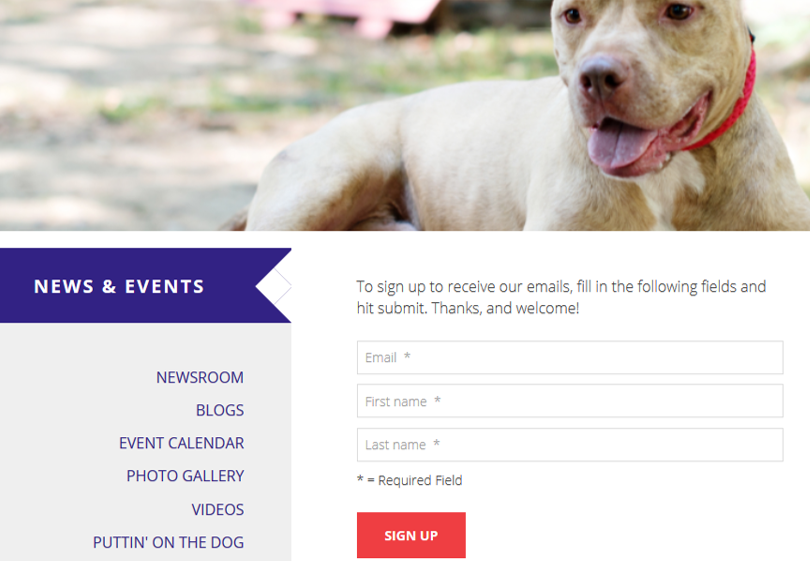
If you’re out speaking, ask people to sign up to hear more about how your nonprofit is making a difference. Make it clear that they will be receiving emails from you. This may seem like extra work, but all email builder tools require that your contacts have opted in, consenting to receive emails. If you skip this step, you could wind up with a lot of spam complaints and people requesting to opt out of your emails which could lead to suspension or cancellation of your email service.
2. Offer a way to Opt Out. You must give people a way to easily get off your list. If you use Mail Chimp or Constant Contact, there’s always a link at the bottom of every email that people can click to opt out. If you’re one of the few nonprofits trying to use Outlook or gmail to send newsletters to your list (which is a really bad idea), you should add instructions for opting out at the bottom of your email. I’ve personally been on a list like that that I did not ask to be on and it was a pain to get them to take me off the list.
Here’s an example of an opt-out (it’s the Unsubscribe link):
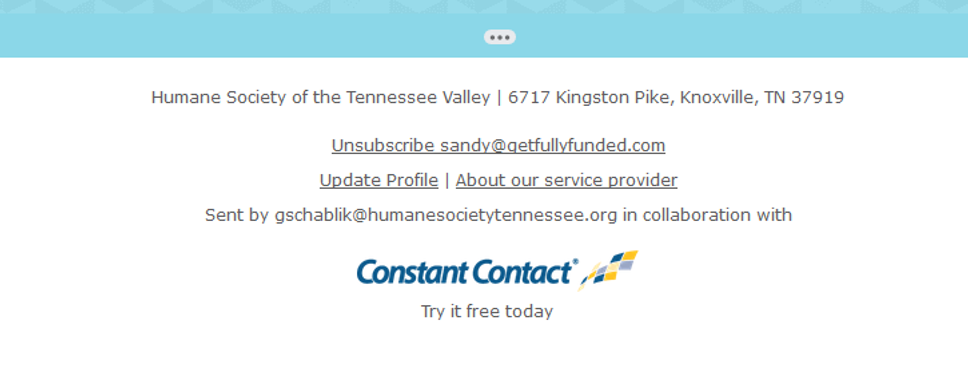
A note about opt outs: I know you want as big of a list as you can get and you don’t want to lose anyone. But understand that people WILL opt out. Their email address changes or their interests change and they no longer want to receive info from you. Or maybe you’ve sent so many boring emails in a row that they don’t want to suffer through another one. If you’ve sent the best e-newsletters and updates you possibly can and a few people opt out from each one, that’s normal. Just remember that for every person who opts out, they’re making space for a more loyal supporter to opt in.
According to Constant Contact, the average opt out rate for nonprofits is 0.01%.
3. Subject Lines. Every day, people’s inboxes are flooded with emails with everything from coupons to meeting requests to funny videos. In fact, the average working person receives around 90 emails a day! So, how do you get your busy donors to open your emails? It all starts with the subject line.
The subject line has one job: get the email open.
Opening your email is the first critical step in getting your donors to read your newsletter, and the only way they will open your e-newsletter is if you have an interesting subject line that grabs your donor’s attention. A subject line of “May Newsletter” or “Issue 357” just won’t cut it – it’s vague and boring.
Instead, you’ll need to get creative with your subject lines.
- Keep it short. Most people are checking email on their phones nowadays, so the subject line of your email newsletter must to be short enough to fit on a mobile device.
- Ask a question. People are curious by nature and our minds can’t stand an unanswered question, so asking a question in your subject line can pique the interest of your audience and make them open your email just to see what the answer is.
- Use engaging action verbs. Words like Change, Help, Give, Hear, and See can inspire your donors to open up the email to see what’s inside, especially if they love your nonprofit’s work!
- Get Clever. Use current pop culture references or point to an upcoming Holiday or event. Something like “What does Katie Perry have in common with our homeowners?” combines a question with a famous celebrity and might be intriguing enough for people to open the email.
- Leave out the word Newsletter! Please, please, please DO NOT use the word “newsletter” in the subject line of your newsletter! No one wants to read another newsletter. Try describing the candy, not the wrapper. Donors want to know what’s INSIDE that’s worth reading, so tease it in your subject line.
If you are struggling with subject lines, don’t worry, it happens to everyone. Try this: brainstorm at least 10 subject line ideas for your e-newsletter. You’ll find that the later ones are better than the first ones. Then send them to a co-worker or volunteer to see which subject line resonates the most. This might seem like a time-consuming process but it will pay off in the long run to find a subject line that will resonate with your reader.
Another trick is to keep a list of subject lines you like. Every time you get an email that you open immediately, ask yourself why you did it. What about that subject line grabbed you? Then add it to your list. Your list of great subject lines can be a huge source of inspiration when you need a fresh idea.
4. Keep it brief. Your e-newsletter needs to a quick and easy read for your audience. Don’t try to cram too many things into one e- newsletter. Your audience doesn’t need to know what’s happening in all 25 counties that you serve, or all 7 programs that you run. So only think about including a few sections in your e-newsletter. In this case, less is more!
5. Break it into sections. Break your content into several distinct sections to move the reader’s eye along the page. You can put each section on a light-colored background or simply use a line to separate one section from another. Having several short sections looks easier to read than one long piece of text (and remember if it looks hard to read, people won’t read it!).
Here’s a great example of separating sections in a newsletter from Draft Gratitude. Notice that each section has a heading, a photo, and the text is super short, which is easy to read.
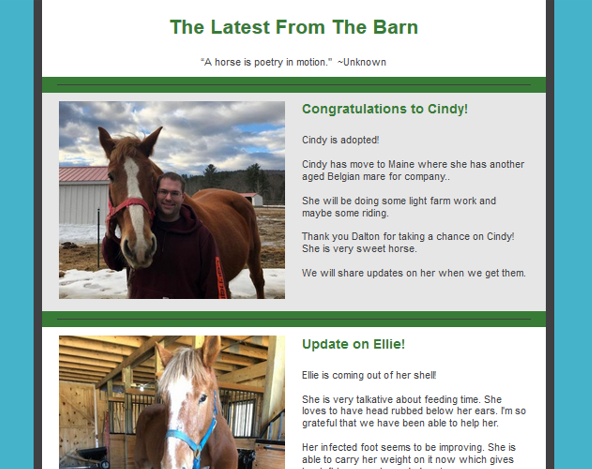
6. Brand it. Be consistent throughout your e-newsletter with colors, fonts, and design elements, and make sure they all match your nonprofit’s brand. Tools like Mail Chimp and Constant Contact make it easy for you customize a template with your brand colors and logos which help your donors easily recognize that the email is from you.
- Create your own customized email header with your logo or use an image that will represent your nonprofit. Find someone who can help you or use Canva to create an email header.
- Stick with brand colors. Just because the crayon box has 256 colors doesn’t mean you need to use them all. In fact, using the same few colors throughout your newsletter (and everywhere else) creates consistency and recognition. If you have a Style Guide that lists out your color names and PMS codes, be sure to use those exact colors.
7. Design for maximum readability. Don’t give anyone any reason not to read your e-newsletter. Keep it simple to skim and easy on the eyes.
- Use white space on purpose. Don’t be afraid of white space or blank space. It helps break up sections and keep your newsletter from being too busy. When you have lots of white space around an important image, the image stands out more.
- Use section headers. At the beginning of each section, use a header to indicate a new section is starting. Section headers are usually just a few words and give the gist of the section like “Save the Date” or “How You Can Help.”
- Use an easy-to-read font. Nothing is worse than trying to read an email where the font is too small or too funky. You don’t want a donor closing your email without reading it simply because they can’t read the font. Choose simple, standard fonts like Calibri or Ariel.
- Use shaded backgrounds cautiously. Be careful about putting text on a shaded background. Some people are color blind and won’t be able to see blue text on a green background. Stick with dark text (black, dark blue, dark brown) on a very light or white background. If you’re not sure whether it’s readable, send a test to a handful of close volunteers and see what they think.
 8. Make it mobile-friendly. Most people are checking email on their phones these days so it’s important to make sure the emails you are sending out are mobile-friendly or easy to read on a smart phone. Nearly every email builder tool has designed their emails to be mobile-friendly, so if you’re using Mail Chimp or Constant Contact, you’re good to go.
8. Make it mobile-friendly. Most people are checking email on their phones these days so it’s important to make sure the emails you are sending out are mobile-friendly or easy to read on a smart phone. Nearly every email builder tool has designed their emails to be mobile-friendly, so if you’re using Mail Chimp or Constant Contact, you’re good to go.
- Use ONE column. Columns are difficult to read online and particularly difficult on a tablet or phone. Just don’t use multiple columns.
- Use smaller or fewer images. Pictures are large files and can cause a slow load time for your email so don’t overuse them.
Once you get an email template created, make sure to test it on multiple devices to make sure it will look right no matter how your audience is reading it. That means read the test on your phone. Ask a co-worker to read it on their phone. Try it on a tablet. Also test it on an Apple product and a PC-based product to make sure there’s no weirdness (there shouldn’t be, but you never know!).
9. Be consistent. If you are randomly sending out your e-newsletter throughout the month or year, you are missing an opportunity. Sending out a regular monthly or even twice-monthly newsletter is a great way to keep your donors in the loop about what’s going on in your organization AND it trains them to look for your next issue. You can decide what frequency will work best for you, but whatever you decide, commit to it. For nonprofits that are just getting started, a quarterly e-newsletter may work best. While older nonprofits may find that monthly e-newsletters work best for them and their audience. No matter how often you are sending out your e-newsletter, be consistent!
To help you stay on track, keep a “Send Schedule” and an editorial calendar for your upcoming e-newsletters. It doesn’t have to be anything fancy, just a simple electronic calendar or spreadsheet will work. Then schedule the production process for the newsletter so you know when you need to start working on it in order to be able to hit the “Send” button on the scheduled date. No one does their best work at the last minute so make sure give yourself plenty of time to work on it!
10. Focus on ONE Call To Action (CTA). It’s very tempting to include several asks in your e-newsletter but remember that its purpose is communication and engagement. If you include too many asks, your e-newsletter is no longer a warm touch and it will leave your donors feeling like all you want is their money. Include only ONE CTA towards the end of your e-newsletter.
Here are a few ideas for CTAs you can use in your e-newsletter:
- Donate to a specific one-time thing like equipment or items that are in low supply
- Volunteer
- Give something from our Wish List (include a link to Amazon or other store so it’s easy for people to buy what you need)
- Purchase a ticket to an upcoming event
Stay away from things with a low return on investment like asking people to add you on Amazon Smile or attend a charity restaurant night. These don’t generate much return for the effort you put in, so don’t include them as a CTA.
11. Include social media buttons. Most email builder templates have a space for your social media buttons, so be sure to connect them to your nonprofit’s Facebook, Twitter, or Instagram accounts. You’ll soon have more followers on social media!
Here’s a an example featuring social media icons from Illuminate India. Notice the CTA and the soft unsubscribe language:
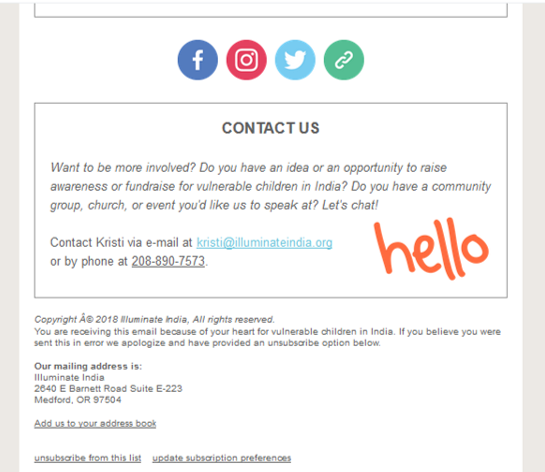
12. Always double-check and TEST. It might seem like a hassle to make time to test your e-newsletters before you send them out, but there are so many things that can go wrong and it’s better to catch that typo, broken link, or wrong photo BEFORE you hit “Send.”
Make sure to test on both your computer and your phone because each device may show the newsletter differently, and both devices will be used by your audience.
Use this checklist when you are testing your e-newsletter:
- Does your subject line make sense? Is it short enough that it will fit on a mobile phone?
- Double check any dates in your email to make sure they are correct.
- Are the images loading correctly?
- Does the formatting look the same on your computer and mobile device as it does in your email builder tool?
- Are the links working? Did you check every single one? Even the social media links?
- Spellcheck and grammar check your content.
Once you have gone through this checklist, send your email to a coworker or volunteer and ask them to read through your email to check for spelling, grammar, and obvious errors (bonus points if they are an experienced writer!). It is easy to miss small things while writing so it’s always a good idea to have someone else read through the final version before it goes out to hundreds or thousands of contacts.
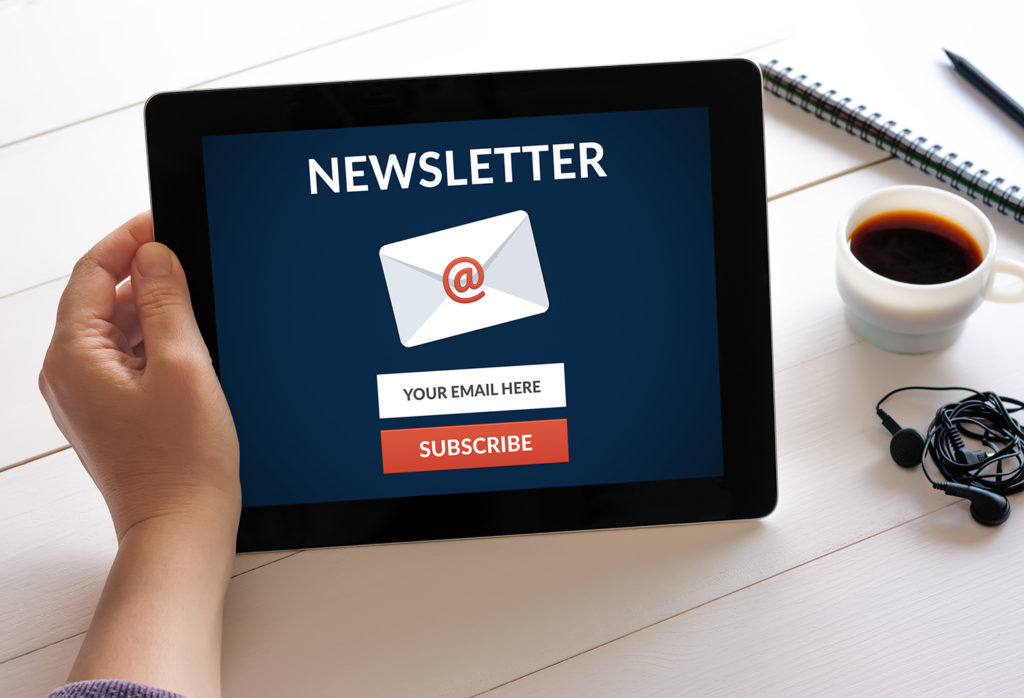
13. Subscribe to other nonprofits’ e-newsletters. By reading others’ work, you’ll get ideas for what to include in your own e-newsletters. It doesn’t cost anything and it will give you a great experience of being intrigued or repelled by subject lines and content.
14. Check your open rates. Most email builder platforms have an easy way to check open rates after an email has been sent. It is important to monitor your open rates after sending out an email to find out what emails are being opened and clicked. Open rates and click-through rates vary from organization to organization. However, according to Mail Chimp, on average nonprofit emails have a 11% open rate and a 2.57% click through rate. If you are at or over that percentage, pat yourself on the back! If you are below those percentages, then you may need to work on your subject lines, content, or consistency. A low open rate is a sign that your subject line is not engaging enough and a low click-through rate is a sign that your CTA is not compelling enough.
15. Keep your email list clean. Your contact list is an incredibly valuable asset to your nonprofit and keeping it clean and updated is critical. If your email list isn’t cleaned up regularly, it can lead to all kinds of issues from increased spam complaints to misspellings in your donors’ names which can kill your chances of engagement.
Here are some tips for good list hygiene.
- Add clean data. Make sure that when you add new data manually that you spell everything correctly especially your donor’s name! Spot check data from online forms that donors have entered themselves to catch any obvious typos or anything entered in all caps.
- Run a de-duplicate check. Most email builder platforms have a tool that will allow you to check for duplicate records. Once you find duplicate records, you’ll need to merge the duplicate records together. Sometimes this is a little tricky, especially if a donor is on your list twice with two different email addresses. You might treat those as separate records or you can check with the donor to see if they’d like to use just one of the email addresses. The best rule here is this: Anytime you aren’t sure, don’t assume – ASK the donor.
- Delete opt outs. Contacts that have requested to opt-out or are no longer active (they haven’t opened an email in 6 months or more) can be deleted from your email list. If you have a mailing address or if they have given a donation in the past, don’t delete them from your donor-tracking software. Just don’t email them anymore. Your email builder tool should have a report you can run to find these contacts.
- Clean up bounced emails. “Bouncing” means that the email could not be delivered to the recipient’s email address. There are a variety of reasons why, but the most common reason is that the contact’s email address is no longer being used. When this happens, you should pick up the phone and call the contact to get an updated email address. If you don’t have a phone number or can’t reach them, go ahead and delete them from your email list.
The Bottom Line
Nonprofit newsletters are a critically important tool in building relationships with donors.
Both the content of the e-newsletter and the way it’s set up and sent play key roles in whether or not donors open, read, and act on your newsletter. Take the time to get both right and you’ll see your open-rate climb and more engagement from your donors.
Additional Resources
Mail Chimp has a free option for less than 2,000 subscribers. If you are just getting started with your e-newsletter, you should start with Mail Chimp. Mail Chimp also offers a 15% off discount to nonprofits if you contact their billing team. It integrates with most donor-tracking software like Kindful and Bloomerang
Constant Contact is another great email builder tool with more features than Mail Chimp, but with a higher price tag. However, they also offer a discount for nonprofits. It also integrates with popular donor-tracking tools like Kindful and Bloomerang.
Bloomerang offers a combination of a donor-tracking tool and an email marketing tool. It was designed just for nonprofits, so their email builders were created with nonprofits in mind. They have different pricing plans based on your needs.


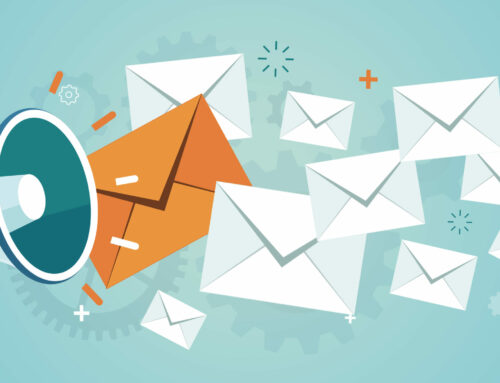


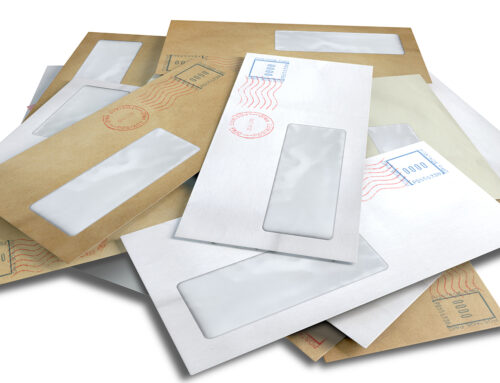
Hi, I want to add that Designmodo builds a tool called Postcards, it’s an email builder. So, if you will contact the guys here https://designmodo.com/postcards/ you can ask for a non-profit discount, they offer really generous discounts.
Just in case you need this type of tool.
Thanks Andrew for letting us know about that one.
Great information! Thank you so much!
You’re welcome Tami! These are literally the steps we follow when we’re sending out our newsletter each week. 🙂